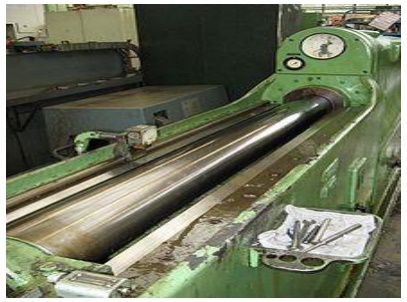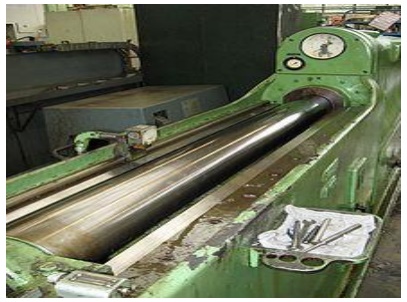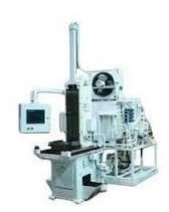Chapter: Mechanical : Manufacturing Technology : Abrasive Process and Broaching
Broaching Machines

Broaching Machines
Broaching
machines are relatively simple as they only have to move the broach in a linear
motion at a predetermined speed and provide a means for handling the broach
automatically. Most machines are hydraulic, but a few specialty machines are
mechanically driven. The machines are distinguished by whether their motion is
horizontal or vertical. The choice of machine is primarily dictated by the
stroke required. Vertical broaching machines rarely have a stroke longer than
60 in (1.5 m).

·
Vertical broaching machines can be designed for
push broaching, pull-down broaching, pull-up broaching, or surface broaching.
Push broaching machines are similar to an arbor press with a guided ram;
typical capacities are 5 to 50 tons. The two ram pull-down machine is the most
common type of broaching machine. This style machine has the rams under the
table. Pull-up machines have the ram above the table; they usually have more
than one ram. Most surface broaching is done on a vertical machine.
·
Horizontal broaching machines are designed for
pull broaching, surface broaching, continuous broaching, and rotary broaching.
Pull style machines are basically vertical machines laid on the side with a
longer stroke. Surface style machines hold the broach stationary while the
workpieces are clamped into fixtures that are mounted on a conveyor system. Continuous style machines are similar to the
surface style machines except adapted for
internal broaching.
·
Horizontal machines used to be much
more common than vertical machines, however today they represent just 10% of
all broaching machines purchased. Vertical machines are more popular because
they take up less space.
Push Type Broaching Machine

Vertical internal
push-down: Vertical push-down machines are
often nothing more than general-purpose hydraulic presses with special
fixtures. They are available with capacities of 2 to 25 tons, strokes up to
36" and speeds as high as 40 FPM. In some cases, universal machines have
been designed which combine as many as three different broaching operations,
such as push, pull, and surface, simply through the addition of special
fixtures.
Pull Type Broaching Machine

Vertical internal pull-up: The pull-up type, in which the workpiece is placed below the
worktable, was the first to be introduced. Its
principal use is in broaching round and irregular
shaped holes. Pull-up machines are now furnished
with pulling capacities of 6 to 50 tons,
strokes up to 72", and broaching speeds of
30 FPM. Larger machines are available; some
have electro-mechanical drives for greater
broaching speed and higher productivity.
Vertical internal pull-down: The more sophisticated pull-down machines, in which the work
is placed on top of the table, were developed
later than the pull-up type. These pull-down
machines are capable of holding internal shapes
to closer tolerances by means of locating
fixtures on top of the worktable. Machines come
with pulling capacities of 2 to 75 tons, 30"
to 110" strokes, and speeds of up to 80
FPM.
Related Topics